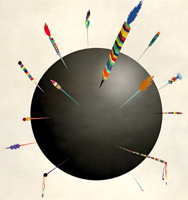Difference between revisions of "Mode"
From Nordan Symposia
Jump to navigationJump to search (Created page with 'File:lighterstill.jpgright|frame ==Origin== [http://nordan.daynal.org/wiki/index.php?title=English#ca._1100-1500_.09THE_MIDDLE_ENGLISH_PERIOD Middl...') |
m (Text replacement - "http://" to "https://") |
||
| (One intermediate revision by the same user not shown) | |||
| Line 2: | Line 2: | ||
==Origin== | ==Origin== | ||
| − | [ | + | [https://nordan.daynal.org/wiki/index.php?title=English#ca._1100-1500_.09THE_MIDDLE_ENGLISH_PERIOD Middle English] moede, from [[Latin]] modus [[measure]], [[manner]], musical mode |
| − | *[ | + | *[https://en.wikipedia.org/wiki/14th_century 14th Century] |
==Definitions== | ==Definitions== | ||
*1a : an arrangement of the eight diatonic notes or [[tones]] of an [[octave]] according to one of several fixed schemes of their intervals | *1a : an arrangement of the eight diatonic notes or [[tones]] of an [[octave]] according to one of several fixed schemes of their intervals | ||
| Line 18: | Line 18: | ||
*8: any of various stationary [[vibration]] [[patterns]] of which an elastic [[body]] or oscillatory system is capable <the [[vibration]] mode of an airplane propeller blade> <the vibrational modes of a [[molecule]]> | *8: any of various stationary [[vibration]] [[patterns]] of which an elastic [[body]] or oscillatory system is capable <the [[vibration]] mode of an airplane propeller blade> <the vibrational modes of a [[molecule]]> | ||
==Description== | ==Description== | ||
| − | In [[semiotics]], a '''modality''' is a particular way in which the [[information]] is to be encoded for presentation to [[humans]], i.e. to the type of sign and to the [[status]] of [[reality]] ascribed to or claimed by a sign, [[text]] or [[genre]]. It is more closely [[associated]] with the [[semiotics]] of [ | + | In [[semiotics]], a '''modality''' is a particular way in which the [[information]] is to be encoded for presentation to [[humans]], i.e. to the type of sign and to the [[status]] of [[reality]] ascribed to or claimed by a sign, [[text]] or [[genre]]. It is more closely [[associated]] with the [[semiotics]] of [https://en.wikipedia.org/wiki/Charles_Sanders_Peirce Charles Peirce] (1839-1914) than [https://en.wikipedia.org/wiki/Ferdinand_de_Saussure Saussure] (1857-1913) because [[meaning]] is conceived as an [[effect]] of a set of signs. In the Peircean model, a reference is made to an object when the sign (or representamen) is [[interpreted]] recursively by another sign (which becomes its interpretant), a conception of [[meaning]] that does in fact imply a [[classification]] of sign [[types]].[https://en.wikipedia.org/wiki/Modality_%28semiotics%29] |
[[Category: Languages and Literature]] | [[Category: Languages and Literature]] | ||
Latest revision as of 01:24, 13 December 2020
Origin
Middle English moede, from Latin modus measure, manner, musical mode
Definitions
- 1a : an arrangement of the eight diatonic notes or tones of an octave according to one of several fixed schemes of their intervals
- b : a rhythmical scheme (as in 13th and 14th century music)
- 2: mood
- 3[Late Latin modus, from Latin] a : mood 1 b : the modal form of the assertion or denial of a logical proposition
- 4a : a particular form or variety of something <flying and other modes of transport>
- b : a form or manner of expression : style
- 5: a possible, customary, or preferred way of doing something <explained in the usual solemn mode>
- 6a : a manifestation, form, or arrangement of being; specifically : a particular form or manifestation of an underlying substance
- b : a particular functioning arrangement or condition : status <a computer operating in parallel mode>
- b : a value of a random variable for which a function of probabilities defined on it achieves a relative maximum
- 8: any of various stationary vibration patterns of which an elastic body or oscillatory system is capable <the vibration mode of an airplane propeller blade> <the vibrational modes of a molecule>
Description
In semiotics, a modality is a particular way in which the information is to be encoded for presentation to humans, i.e. to the type of sign and to the status of reality ascribed to or claimed by a sign, text or genre. It is more closely associated with the semiotics of Charles Peirce (1839-1914) than Saussure (1857-1913) because meaning is conceived as an effect of a set of signs. In the Peircean model, a reference is made to an object when the sign (or representamen) is interpreted recursively by another sign (which becomes its interpretant), a conception of meaning that does in fact imply a classification of sign types.[1]
